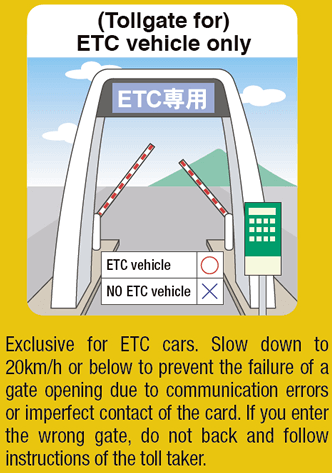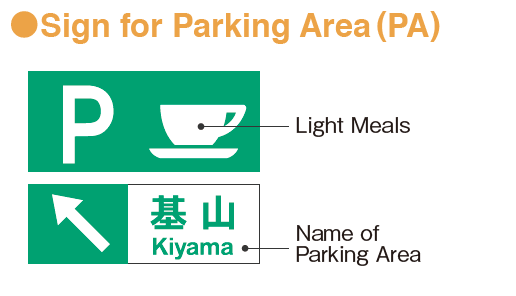How to Drive on Expressways at Entrance
-
at Entrance
Please receive a ticket at the toll booth (except if using ETC). Please do not lose or fold the ticket.

-
at Exit
Please receive a ticket at the toll booth (except if using ETC). Please do not lose or fold the ticket.
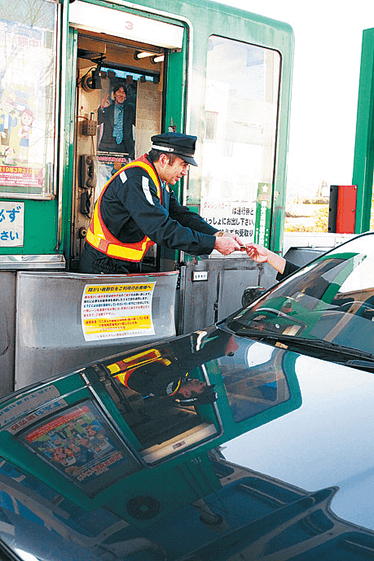
No Equipped with ETC in vehicle device cannot pass ETC Only tollgate.
There are three kinds of lanes at the entrance and the exit of expressways: for ordinary cars, for both ETC and ordinary cars, and exclusively for ETC cars. Please follow indications on these lanes.
How to Read Road Signs
Entrance and Exit Road Signs for Expressways
The color of the road sign plates for Entrance and Exit of expressways is green, and both numbers and names of interchanges are written on them in the Roman alphabet as well as in Japanese so that foreign drivers who are unfamiliar with Japanese names in Kanji (Chinese characters) may use expressways with ease. Information signs at resting areas indicate service contents of the facilities in symbolic marks. Please confirm road names and interchange numbers with road maps in advance.
Drive in the Cruising Lane (Keep Left)!
A 2-lane expressway is divided into the "cruising lane" and "passing lane." Under normal conditions, stay in the cruising lane on the left hand side (keep left). Only pass in the right-hand lane. As this road traffic (expressway) regulation is strictly enforced, it is advisable to return to the cruising lane after having passed another vehicle.
How to use gas stations
Gas stations are called "GA-SO-RI-N SU-TA-N-DO" in Japan. There have been problems due to confusion over the names of the various types of fuels, so learn what they are beforehand. *The abbreviations GS for gas stations or SS for service stations will be used below.
Where are gas stations?
Gas stations can be commonly seen in urban areas or along the busy main roads, but they are rarely found once you are away from a city or along a road with very little traffic. There are more GS along highways with 2 or more lanes and other roads which large-sized vehicles such as trucks utilize. Regarding operating hours, you should be aware that while some GS are open 24 hours a day in urban areas, some gas stations in the countryside where there is little traffic may close after 18:00 during the week and may not be open at all on weekends. Rather than waiting until you are running very low on gas to fill up, it is advisable to fuel up often.
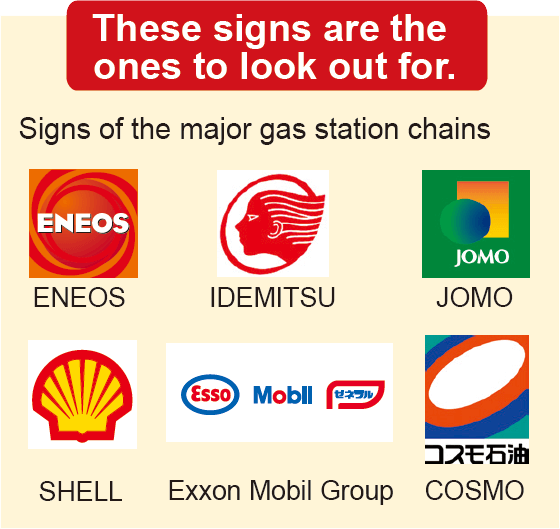
There are two types of gas stations.
There are two types of gas stations: a. "Full Service" where sales staff are always present and refuel for you and b. "Self Service" where you refuel your own car. Prices are slightly cheaper at self-service stands. At full service stands, all you have to do is to tell the staff what kind of gas you want and how much, either in liters or yen. If you want a full tank, just say "MA-N-TA-N" (full tank). The staff will refuel your car and offer services such as wiping your car's windows. Every once in a while, you will be offered a free map or pack of tissues.
There are three types of fuel with two types of gasoline.
Fuel comes in three types including "HI OKU" (high octane), "regular" and "diesel." Rental cars in Japan, for the most part, have gasoline engines and require "regular" gasoline. There are virtually no rental cars with diesel engines so under no circumstances should you use diesel fuel in a rental car. The car will not run if it has been filled up with diesel fuel. Additionally, gasoline sold in Japan is virtually all lead-free.
Refuel at a self-service gas station!
Here is an introduction about how to use self-service gas stations. *Since the system may be different depending on the gas stations, we are giving you just one example here. At some gas stations, drivers pay the amount they owe for the gasoline to the staff at the register after refueling.
1Stop your car alongside the gas pump
Stop your car alongside the gas pump keeping in mind which side your petrol tank is on. Make sure you know in advance which side your gas tank is on. Park the car and turn off the engine.

2Pay first
The fee should be paid beforehand, and cash and credit cards may be used.
- (1) Cash: Insert the amount of money in the loading slot.
- If a driver intends to refuel by 30 l, insert approximately 5,000 to 6,000 yen in bills. The cost is calculated by multiplying the unit costs (per liter) by the amount of gasoline (l) you used, and any change owed will be repaid into the coin return slot.
- (2) Credit card: Activate the card by inserting it.
- Insert your credit card into the appropriate slit and swipe it through the reader to load the data.

3Select the gasoline type and the volume (number of liters)
Select the gasoline you wish to use by pushing the button for either premier, regular or light gasoline. Rental car users usually choose regular. The amount of petrol can be selected in two ways: choose one of 10 l, 20 l, 30 l ... 50 l options or select 1,000 yen, 2,000 yen, 3,000 yen ... 5,000 yen. If a driver wants to fill their car up, MA-N-TA-N should be selected.
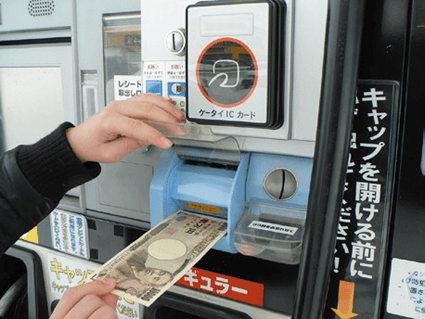
4Refueling
Open your gas tank, pick up the nozzle for the gasoline you have selected, insert the nozzle into your tank firmly. There are usually three types of nozzles, so make sure you select the right type of petrol. Petrol types are always indicated by the same colors. Pull the lever to start refueling. When you have finished refueling, is the petrol will stop automatically (The driver cannot pull the lever anymore).

5Refueling completed
Return the nozzle to the pump, and close the cap of your gas tank firmly. Confirm the amount of gasoline and the charge shown on the display. Don't forget to pick up your change when you pay by cash. A receipt is printed out automatically for use of both cash and credit cards.

Quick Tip
Gasoline is dangerous!
Needless to say, fire, such as cigarettes, must be put out while you are filling your car. If gasoline catches fire, it will be very dangerous. As static electricity is also dangerous, do not forget to touch a static electricity removal sheet before starting to refuel. Use of mobile phones is also prohibited.


